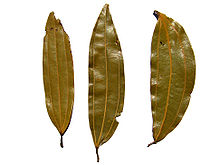Cinnamomum tamala
| Indian bay leaf | |
|---|---|
 |
|
| dried Indian bay leaves | |
| Scientific classification | |
| Kingdom: | Plantae |
| (unranked): | Angiosperms |
| (unranked): | Magnoliids |
| Order: | Laurales |
| Family: | Lauraceae |
| Genus: | Cinnamomum |
| Species: | C. tamala |
| Binomial name | |
|
Cinnamomum tamala (Buch.-Ham.) T.Nees & C.H.Eberm. |
|
| Synonyms | |
|
|
Cinnamomum tamala, Indian bay leaf, also known as tejpat,tejapatta, Malabar leaf, Indian bark,Indian cassia, or malabathrum, is a tree within the Lauraceae family which is native to India, Bangladesh, Nepal, Bhutan, and China. It can grow up to 20 m (66 ft) tall. It has aromatic leaves which are used for culinary and medicinal purposes. It is thought to have been one of the major sources of the medicinal plant leaves known in classic and medieval times as malabathrum (or malobathrum).
The leaves, known as tējapattā or tejpatta () in Hindi and in Nepali, tejpata () in Bengali, tejpat in Assamese, and tamalpatra (तमालपत्र) in Marathi and in original Sanskrit, are used extensively in the cuisines of India, Nepal, and Bhutan, particularly in the Moghul cuisine of North India and Nepal and in tsheringma herbal tea in Bhutan. It is called biryani aaku or bagharakku in Telugu. They are often labeled as "Indian bay leaves," or just "bay leaf", causing confusion with the leaf from the bay laurel, a tree of Mediterranean origin in a different genus, and the appearance and aroma of the two are quite different. Bay laurel leaves are shorter and light to medium green in color, with one large vein down the length of the leaf, while tejpat leaves are about twice as long and wider, usually olive green in color, and with three veins down the length of the leaf. True tejpat leaves impart a strong cassia- or cinnamon-like aroma to dishes, while the bay laurel leaf's aroma is more reminiscent of pine and lemon.
The bark is also sometimes used for cooking, although it is regarded as inferior to true cinnamon or cassia. Methanolic extract of C. tamala leaves fed at 10 mg/kg to alloxan-induced diabetic rats for 15 days resulted in significant reduction in blood glucose level, blood glycosylated haemoglobin, LPO, serum AST, and ALT, and significant increase in the antioxidant enzymes such as CAT, GSH, and SOD. C. tamala could be used as an adjunct therapy in diabetes.
...
Wikipedia
